Angela Kneale, OTD, MA, OTR/L, NBC-HWC

Angela Kneale, OTD, MA, OTR/L, NBC-HWC is an occupational therapist, integrative health coach, Franklin Method® educator, and certified Stott Pilates® instructor. Professional experience includes industrial rehabilitation, employee wellness, and treatment of individuals with chronic pain, physical disabilities, and neurological issues. The author of eight books, Angela specializes in the integration of movement, breathing, postural alignment, and relaxation techniques for optimal health and wellbeing.
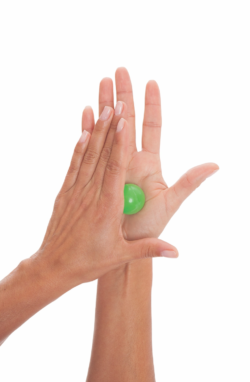
Massage therapy is one of the most effective, widely used integrative therapies for reducing pain, relieving stress, and enhancing immune function. As caring, compassionate healthcare professionals, massage therapists are committed to making positive differences in people’s lives.
Unfortunately, while providing relief to clients, massage therapists are often vulnerable to musculoskeletal injuries themselves – especially in their hands and wrists, even though they’ve received professional training about proper body mechanics, positioning and the importance of self-care. For example, a survey of massage therapists in Canada found a high prevalence of upper extremity pain, with greatest pain and discomfort reported in the wrist and thumb, followed by the low back, neck and shoulders (Albert, Currie-Jackson, & Duncan, 2008).
This information illustrates why self-care regimens that can help massage therapists prevent injury are crucial to career longevity, supporting health and wellbeing. Following are some great tips for helping you take better care of yourself while still taking great care of your clients.
Make Mindfulness Your Practice
Awareness of potential risks provides the vital first step to maximizing your health and safety, reducing risk factors through effective ergonomics, good body mechanics, and positive self-care strategies. Make sure your work space is set up to ensure the best ergonomics possible.
Here, think about the space you’ll need to move around the table while performing massage, as well as how easily you can adjust the table. Lightweight equipment you can easily manoeuvre around, lift and adjust is key to preventing injuries, and helps you avoid prolonged, awkward body positions.
You might also want to use hand-held tools that give you the option of applying sustained pressure while maintaining optimal wrist positioning. Consider alternating between standing and sitting during a massage therapy session and book your appointments to give yourself enough time between sessions to stretch or do a short self-care exercise. Whenever possible vary massage therapy techniques to build opportunities for recovery time into the session.
Mindfulness of breathing, posture and positioning, and body movements are critical to every massage therapist’s application of good body mechanics during work activities. Deep, regular diaphragmatic breathing is an essential component of proper body mechanics and aligned posture, with the additional benefits of enhanced focus, presence, relaxation, and release of stress and tension. Working from a cantered balance point, emphasizing neutral posture, promotes ease of your body movements.
Developing good body mechanics also means you’re using larger muscles of the core, hips, and legs to generate force rather than upper extremity muscles, and varying movements during treatment sessions. From a biomechanical engineering perspective (Mohr, 2010), key concepts for injury prevention include:
• Leveraging your body weight instead of using muscle force
• Stacking joints to avoid rotational forces
• Bracing the back knee and generating more force by pushing from the heel
• Applying forces at 90-degree angles, using the forearm as possible while keeping hand and fingers relaxed
• Positioning the wrist in mid-range when necessary to apply force with the hand
To avoid hand and wrist injuries specifically, keeping wrists neutral is an absolute must – while performing massage therapy, as well all throughout other daily activities such as computer and phone use. Pay attention to your wrist position during massage therapy techniques to help develop positive and protective habits. To help keep wrists straight when applying pressure with your hands, use the forearm or elbow, the back of a loose fist (proximal phalanges), ulnar stylus, ulnar edge of palm, or hand tools. To additionally reduce stress on hands and wrist, use your free hand to reinforce wrist stability, place one palm on top of the other when using a flat palm and use at least two fingers whenever you need to apply pressure.
A Holistic Self-Care Regimen Is Key
Massage therapy is physically and emotionally demanding work that requires multifaceted self-care strategies to ensure flexibility, body awareness, endurance, balance, strength, circulation and alignment. Self-care regimens that support holistic wellbeing are key when considering how to take care of yourself, so you can stay in the massage therapy profession as long as you choose.
Fundamental health principles support whole-body wellness:
• Eat nutrition-dense foods
• Hydrate throughout the day, every day
• Get plenty of sleep
• Move in a variety of ways (include moderate to vigorous exercise to total 30–60 minutes on most days). Also, don’t forget to move and stretch in opposite directions of your routine.
• Relax (meditation, yoga, listening to music, creative activities, spending time with loved ones).
During work with clients, check in with yourself often to notice how your body is feeling, your energy level, and your mood. Make time to consciously breathe, relax, stretch, and rest throughout the day. Breathing deeply, slowly, and regularly helps release tension and stress – calming the body and clearing the mind. Focus on exhaling fully and allow the next breath to arrive deeply and naturally.
Additional self-care recommendations for massage therapists include receiving the benefits of professional massage every week or two, particularly to address common symptoms of hand and wrist soreness. Research has demonstrated the efficacy of moderate pressure massage therapy to reduce hand pain and increase grip strength, with further benefits of reduced anxiety, depressed mood, and sleep disturbances (Field, Diego, Delgado, Garcia, & Funk, 2011). Moderate pressure massage was also identified as critical for achieving therapeutic effects of improved immune function, enhanced attentiveness, reduced pain in syndromes such as fibromyalgia and rheumatoid arthritis, increased vagal activity, decreased cortisol, and reduced depression, anxiety, and heart rate (Field, 2014).
Self-Massage Can Be Good Self-Care
Even when you know that making massage therapy a regular part of your self-care regimen is important, making time for yourself is often challenging – and that’s when knowing some good self-massage techniques can be beneficial. Self-massage, including pressing and rolling with small balls, encourages body-mind connection and playfulness while exploring varieties of hand, wrist, forearm, elbow, shoulder and neck movements.
While every massage therapist has unique needs and interests, incorporating self-care activities that you enjoy makes staying committed to taking care of yourself easier. Small ball rolling and self-massage techniques can easily be included throughout one’s workday to playfully counteract some of the repetitive movements associated with performing massage therapy.
Start with a few movements selected from the book, Ball Rolling for Happy, Healthy Hands, to begin exploring self-massage techniques. Remember to breathe deeply and fully, releasing tightness and tension during every exhalation. Choose the amount of pressure that feels best for you, while staying mindful of your body posture and positioning.
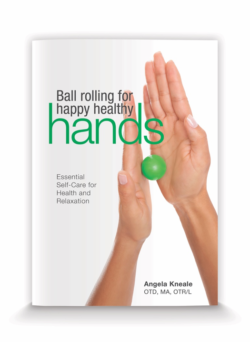
Top of Shoulder Roll & Release
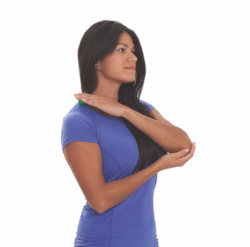
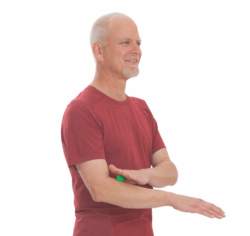
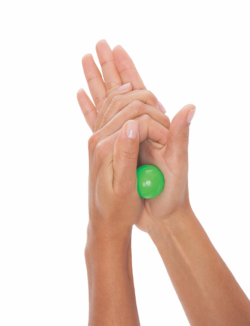
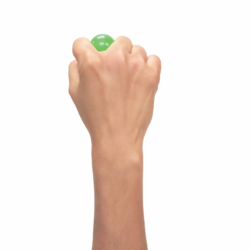
Albert, W. J., Currie-Jackson, N., & Duncan, C. A. (2008). A survey of musculoskeletal injuries amongst Canadian massage therapists. Journal of Bodywork & Movement Therapies, 12, 86-93.
Field, T. (2014). Massage therapy research review. Complementary Therapies in Clinical
Practice, 20, 224-229.
Field, T., Diego, M., Delgado, J., Garcia, D., & Funk, C. G. (2011). Hand pain is reduced by massage therapy. Complementary Therapies in Clinical Practice, 17, 226-229.
Mohr, E. G. (2010). Proper body mechanics from an engineering perspective. Journal of Bodywork & Movement Therapies, 14, 139-151.
Ball Rolling for Happy, Healthy Hands and Small Health Balls are available from OPTP.com